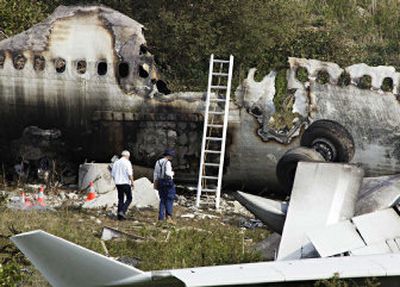Airport was at red alert

TORONTO – Toronto’s airport was under “red alert” because of the threat of lightning when an Air France jetliner landed in a fierce rainstorm despite having enough fuel to reach another airport – a decision that was made by the pilot, airport authorities said Wednesday.
Investigators searching the wreckage of the Airbus A340 found the flight data and voice recorders – the so-called black boxes, said Steve Shaw, spokesman for the Greater Toronto Airports Authority. Officials hope the recorders will provide clues to what caused the aircraft to skid off a runway Tuesday at Lester B. Pearson International Airport and burst into flames.
All 309 passengers and crew escaped alive in an evacuation that took less than two minutes. Air France said 22 people were injured, while airport officials said 43 were hurt. The wreckage of the jetliner – torn into three pieces – still smoldered Wednesday.
Brian Lackey, vice president of operations for the Greater Toronto Airport Authority, said Wednesday the jetliner had enough fuel to divert to Montreal or another airport where the weather was better, but “that’s the pilot’s decision.”
The airport was under a “red alert,” which indicates potential for lightning but does not prevent planes from landing or taking off, officials said.
Real Levasseur, lead investigator for Canada’s Transportation Safety Board, said the decision to land during a “red alert” would be investigated.
He emphasized that wind shear likely wasn’t a factor in the crash – as has been speculated – because that usually would only affect aircraft in flight. He also doubted lightning played a role.
Levasseur said the black boxes were in relatively good condition.
Lackey said airport workers were struck by the severity of the storm. “As we were looking out the window we were commenting that storm was extremely severe,” he said. “Normally if there are thunderstorms in the area, a pilot may decide to circle until it’s safe to land.”
Airport Fire Chief Mike Figliola said three-quarters of the passengers and crew managed to escape in the 52 seconds it took for emergency crews to arrive. “The crew did a great job. They’re trained to get the people off,” Figliola said.
At Air France headquarters in Roissy, France, airline chairman Jean-Cyril Spinetta also praised the flight crew. “I don’t know if we should speak of a miracle … but above all the professionalism of the crew,” Spinetta said.
He said the co-pilot, who was in charge of the landing, had 10,700 hours of flying time, and the 57-year-old pilot had 15,000 hours.
Spinetta said Air France bought the aircraft new on Sept. 7, 1999. It was last serviced July 15 and had logged 28,418 flight-hours and 3,711 takeoffs and landings.
He said it was too early to determine the cause of the crash, the first of an Airbus A340 in its 13 years of commercial service.